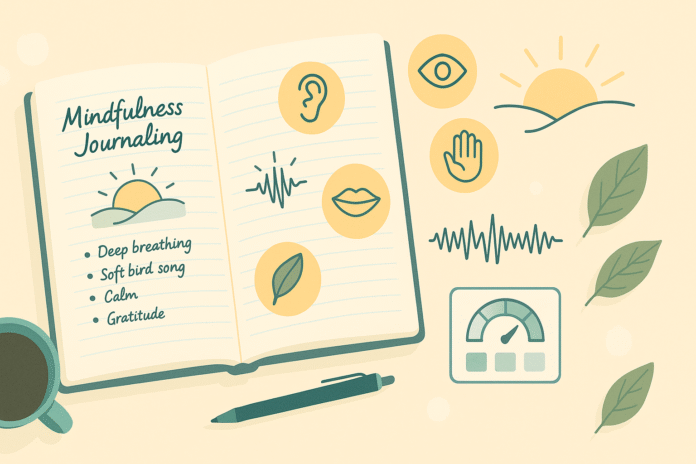If your mindfulness journaling routine feels a little flat lately, you’re not alone. Even a great habit can drift into autopilot. The good news? A few creative tweaks can make your practice feel fresh, rewarding, and easier to sustain. This guide dives into five inventive methods—each with clear steps, beginner-friendly modifications, and practical metrics—so you can level up your mindfulness journaling routine without adding complexity or pressure.
Key takeaways
- Small, creative shifts (like adding senses, sound, or nature) can reignite consistency and deepen awareness.
- Structure beats willpower: prompt stacks, theme weeks, and mini rituals reduce decision fatigue and keep entries flowing.
- Track what matters—mood, energy, and presence—so you can see real-world benefits and adjust intentionally.
- Start tiny, then expand: each method includes quick wins, progressions, and safe-guard rails to avoid overwhelm.
- One month is enough to notice tangible improvements; use the 4-week plan to test, measure, and refine.
1) The 5-Senses Sketchbook: Turn Awareness Into Visual Notes
What it is & why it works
The 5-Senses Sketchbook blends written mindfulness with simple sketches, color, and sensory labeling. Instead of only describing your present-moment experience, you map it—sights, sounds, smells, textures, and tastes—so your brain gets multiple channels of attention. This nudges you out of rumination and into the here-and-now, making your entries more vivid and memorable.
Core benefits:
- Anchors attention using sight and touch.
- Makes mindful moments easier to recall later.
- Breaks perfectionism by prioritizing marks and sensory words over “good writing.”
Requirements & low-cost alternatives
- Nice to have: Unlined notebook or sketchbook; 2–4 colored pens or pencils; small glue stick for clipping/labels.
- Low-cost: Any notebook + a black pen. Use boxes, underlines, or arrows to create “maps” without art supplies.
Step-by-step (beginner friendly)
- Set a 5-minute timer. Title the page with date + location.
- Divide the page into five quick zones: see, hear, smell, taste, touch.
- Scan slowly (30–60 seconds per sense). Jot single words first.
- Add small sketches or symbols (e.g., coffee mug, window outline, a zigzag for AC hum).
- Circle one detail that feels soothing or interesting and add a 2-sentence reflection: “When I notice ___, my body feels ___.”
Modifications & progressions
- Easier: Start with three senses (see/hear/touch) for 3 minutes total.
- For “non-artists”: Use icons (● ▲ ■), arrows, and labels.
- Progression: Color-code emotions (blue=calm, red=tense); add a tiny breath graph (draw a wave for 5 in/5 out).
Frequency & metrics
- Frequency: 3–5 days/week, 5–10 minutes per session.
- Metrics (simple):
- Presence score (0–10) before & after.
- Number of sensory words captured.
- One-line “most grounding detail” logged per day for weekly review.
Safety, caveats, and common mistakes
- Don’t chase “beautiful pages.” The goal is attention, not aesthetics.
- If a sense is triggering (e.g., strong smell), skip it; note the choice without judgment.
- Common mistake: turning it into a scrapbook marathon. Keep it short.
Mini-plan example
- Draw five boxes labeled with senses.
- Fill each with 3–5 words or tiny doodles.
- Close with one sentence: “Right now I’m okay because I notice ___.”
2) Prompt Stacks & Theme Weeks: Structure That Sparks Insight
What it is & why it works
A prompt stack is a mini-sequence of 2–3 micro-prompts you answer in the same order every day, typically under 10 minutes. A theme week rotates the stack’s focus (e.g., Gratitude Week, Self-Kindness Week, Values Week). This rhythm reduces decision fatigue and builds depth without repetition fatigue.
Core benefits:
- Consistency via routine plus novelty via weekly theme.
- Gently covers multiple facets of mindfulness—awareness, acceptance, intention.
- Makes progress visible across days.
Requirements & low-cost alternatives
- Need: Any notebook or notes app.
- Optional: Printed prompt cards or sticky notes to keep on your desk.
Step-by-step (starter stack)
- Set your week’s theme. Example: Gratitude.
- Pick your stack (3 prompts, same order daily):
- Notice: “What is one sensation in my body right now?”
- Name: “What is one thing I appreciate in this moment?”
- Nudge: “What is one tiny action that supports today’s intention?”
- Write 1–3 lines per prompt. Stop when the timer dings (6–8 minutes).
Modifications & progressions
- Easier: 2 prompts only (Notice + Nudge).
- Progression: Add a 4th “Let go” line to release one worry in a neutral tone.
- Creative twist: Once a week, answer the stack in haiku or mind-map bubbles to keep it playful.
Frequency & metrics
- Frequency: Daily or weekdays.
- Metrics:
- Completed prompts/day (2 of 3 still counts).
- A weekly 1–10 “alignment with values” score.
- Count of “tiny nudges” actually done by day’s end.
Safety, caveats, and common mistakes
- Avoid turning the stack into a “performance.” One honest line per prompt is enough.
- If a theme stings (e.g., during grief), switch to Gentle Presence Week (Notice + Nudge only).
- Common mistake: adding too many prompts. Keep it tight.
Sample mini-plan (Gratitude Week)
- Mon–Fri: Answer Notice → Name → Nudge (1–3 lines each).
- Friday: Add one sentence, “What changed this week because I paid attention?”
3) Audio-to-Ink Reflection Loop: Walk, Talk, Transcribe, Annotate
What it is & why it works
Some minds unlock clarity through voice before pen. The Audio-to-Ink Loop lets you speak a mindful debrief while walking or sitting, then transcribe and annotate it later. You separate expression (audio) from processing (annotations), reducing self-censorship and making insights easier to capture.
Core benefits:
- Lowers friction when you feel too scattered to write.
- Captures tone and emotion that text alone can miss.
- Turn rambling thoughts into concise insights via same-day annotation.
Requirements & low-cost alternatives
- Need: Phone voice recorder or any free recording app.
- Optional: Auto-transcription (built-in tools or web services), headphones for playback.
- Low-tech alternative: Record once, replay, and handwrite key phrases—no transcription required.
Step-by-step (10–15 minutes total)
- Choose a focus: “What did my body need most today?” (or use your Theme Week).
- Record 3–5 minutes of continuous, gentle narration. Speak as if talking to a kind friend.
- Transcribe (auto or manual).
- Annotate with a highlighter: mark these tags in the margin—Emotion, Need, Insight, Next tiny step.
- Write a 2-line summary at the bottom: “What I learned… What I’ll try.”
Modifications & progressions
- Easier: Skip transcription; jot 5 short bullets after listening once.
- Privacy-first: Record, extract 3 insights, then delete the file.
- Progression: Create “insight reels”—a monthly page of golden sentences that recur.
Frequency & metrics
- Frequency: 2–3 times/week.
- Metrics:
- Duration of audio (minutes).
- Number of tags per session (Emotion/Need/Insight/Next step).
- Follow-through on “next steps” within 48 hours.
Safety, caveats, and common mistakes
- Privacy: Use passcode protection; avoid naming others in ways you wouldn’t want shared.
- Walking safety: If recording outside, stop moving when speaking near streets or switch to seated recordings.
- Common mistake: Transcribing too much. Aim for key ideas, not a novel.
Mini-plan example
- Record 4 minutes: “What pulled my attention today?”
- Highlight three moments; label each with one emotion + one need.
- Choose one tiny step for tomorrow.
4) Data-Meets-Dharma Dashboard: Track States, Not Scores
What it is & why it works
This method blends mindful journaling with a lightweight dashboard of daily states: mood, energy, sleep quality, and presence. You’re not “gamifying” your inner life; you’re simply watching patterns so your journal can address causes, not just symptoms. Numbers become pointers for compassionate curiosity.
Core benefits:
- Helps you notice triggers and supports (sleep, hydration, social time).
- Shows whether your journaling routine is actually helping.
- Turns vague “I feel off” days into tractable experiments.
Requirements & low-cost alternatives
- Need: Any notebook; a single page formatted as a monthly grid.
- Optional: Ruler, two colored pens (one for entries, one for weekly reflections).
- Low-cost: Draw a simple 5-row table for Mood/Energy/Sleep/Presence/Nudge.
Step-by-step
- Create a one-page dashboard with columns for each day and rows for: Mood, Energy, Sleep Quality, Presence, and “Nudge done?”
- Pick your scales (0–10 or emoji). Define what 3, 5, and 8 mean to you.
- Two-minute daily log: mark the four states + check if you completed your journaling “nudge.”
- Weekly review (10 minutes): circle the highest and lowest days; write one sentence: “What probably helped?” and “What probably hurt?”
Modifications & progressions
- Easier: Track only Presence and Mood for two weeks.
- Progression: Add a Triggers/Supports sidebar: coffee, screens after 9 pm, walk, friend call, etc.
- Tech-lite: Use a calendar sticky on your wall with smiley/frowny stickers.
Frequency & metrics
- Frequency: Daily check-ins; weekly review.
- Metrics:
- Rolling 7-day average of Presence.
- Percentage of days you completed the “nudge.”
- “Volatility” (how big the daily swings are). Goal: smoother trends, not higher numbers.
Safety, caveats, and common mistakes
- The dashboard is descriptive, not judgmental. If numbers create pressure, switch to symbols or colors.
- Don’t compare your marks to anyone else’s.
- Common mistake: tracking 10+ variables. Keep it to 4–5 max.
Mini-plan example
- Draw 4 rows (Mood, Energy, Sleep, Presence) × 7 columns for the week.
- Log each evening in 90 seconds.
- Sunday night: write one sentence, “Next week I’ll test ___.”
5) Nature Sit-Spot & Micro-Safari: Let the Outdoors Do the Prompting
What it is & why it works
A sit-spot is a place you return to regularly—balcony, park bench, garden step—where you observe the living world with friendly curiosity. A micro-safari is a short, slow walk where you collect tiny observations: colors, shadows, leaf shapes, bird calls. Nature gently entrains your attention, making meditative awareness almost automatic.
Core benefits:
- Calms the nervous system with gentle sensory input.
- Refreshes creativity and perspective.
- Anchors your journaling to a consistent, restoring context.
Requirements & low-cost alternatives
- Need: A safe sit-spot (indoors by a window is fine), notebook, pen.
- Optional: Small timer, weather-proof sit pad, pencil for cold days.
- Low-cost: Use a single index card for each session.
Step-by-step
- Choose your spot and commit to visiting it 2–4 times per week.
- Two deep breaths to arrive. Start a 5–8 minute timer.
- Write three columns: See / Hear / Feel. Log short phrases.
- Add one metaphor or comparison (“Clouds like slow ferries”).
- Close with one gratitude for the place or a tiny stewardship note (“Pick up one piece of litter”).
Modifications & progressions
- Easier: Observe from a window if going outside isn’t practical.
- Progression: Track seasonal changes weekly; sketch the same tree or skyline each visit.
- Creative twist: Press a leaf or trace a shadow to include a texture.
Frequency & metrics
- Frequency: 2–4 sessions/week.
- Metrics:
- “Ease of arrival” score (0–10) at start and end.
- Number of unique observations per session.
- Monthly “favorite moment” line you can re-read.
Safety, caveats, and common mistakes
- Choose well-lit, safe areas; tell someone your route if you walk.
- If weather or air quality is poor, move indoors.
- Common mistake: turning the sit-spot into a productivity task. This is restorative time.
Mini-plan example
- Pick a nearby tree or window view.
- Log 5 sensory notes + 1 metaphor.
- Close with one gentle breath cue: “In, I arrive. Out, I soften.”
Quick-Start Checklist
- Pick one creative method from the five that feels easiest this week.
- Set a tiny container: 5–8 minutes per session.
- Attach to an anchor: after coffee, before lunch, or right before bed.
- Prepare supplies: notebook + one pen (extras are optional).
- Decide your metric: Presence score (0–10) before/after each session.
- Choose a “nudge”: one supportive action you’ll take after journaling (glass of water, 3-minute stretch, text a friend).
- Plan the review: 10 minutes on Sunday to glance at entries and note one lesson.
Troubleshooting & Common Pitfalls
“I don’t know what to write.”
Start with Notice → Name → Nudge: one sensation, one appreciation, one tiny action. Or use the 5-Senses boxes to bypass words entirely.
“I keep skipping days.”
Shrink the habit. One line counts. Set an absurdly easy minimum (30 seconds) so it survives bad days.
“My entries feel repetitive.”
Introduce a Theme Week. Try Self-Kindness or Nature. Or swap to audio one day per week.
“I overthink the ‘right way’ to do this.”
There is no right way. If attention felt a little steadier, you did it right. If not, adjust the container (shorter time, simpler prompts).
“Metrics make me anxious.”
Use emojis or color swatches instead of numbers. Or log only a before/after word (“scattered → steady”).
“I’m worried someone will read my journal.”
Use a secure app, a simple cipher for names, or keep a separate “burn page” you shred after writing.
“I try to fix myself instead of noticing.”
Keep a 70/30 ratio: 70% noticing, 30% nudging. Awareness first, then one gentle action.
“I start strong, then fade.”
Schedule a novelty bump every Friday (haiku, collage, or a different pen). Novelty sustains attention.
How to Measure Progress (Without Killing the Joy)
Pick 2–3 indicators and track them lightly for 4 weeks:
- Presence score (0–10) before and after each session.
- Streaks & consistency: number of sessions per week (3/5, 4/7, etc.).
- Mood & energy: single-word or emoji logs.
- Follow-through: percentage of “nudges” completed within 24 hours.
- Re-readability: once a week, star any entry that feels useful or soothing on reread.
What “better” can look like
- Faster landing: your before presence score slowly rises over time.
- Smoother days: fewer extreme swings in mood/energy.
- Clearer next steps: less time dithering, more quick nudges taken.
- More self-kind language showing up naturally in entries.
Monthly review (15 minutes)
- Skim starred entries.
- Write three bullets: Keeps me grounded, Gets in the way, Next tiny experiment.
- Adjust one variable only (time, method, or location) for the next month.
A Simple 4-Week Starter Plan
Week 1 — Ease & Arrival
- Method: 5-Senses Sketchbook (3 senses only).
- Container: 5 minutes, Mon/Wed/Fri.
- Metric: Presence score before/after.
- Nudge: One glass of water post-entry.
- Goal: Notice at least one grounding detail per session.
Week 2 — Structure & Intention
- Method: Prompt Stacks (Notice → Name → Nudge).
- Container: 6–8 minutes, 5 days.
- Metric: Count prompts answered; rate day-end follow-through on the nudge (yes/no).
- Friday review: One sentence on what changed because of the stack.
Week 3 — Expression & Clarity
- Method: Audio-to-Ink Loop, twice; Sketchbook or Stacks on other days.
- Container: 12–15 minutes on audio days (record + annotate); 5–8 otherwise.
- Metric: Number of tagged insights (Emotion/Need/Insight/Next step).
- Safety: Use seated recordings if you’re tired or walking near traffic.
Week 4 — Pattern-Spotting & Nature
- Method: Data-Meets-Dharma dashboard + two Nature Sit-Spot sessions.
- Container: Dashboard daily (2 minutes); Sit-Spot 2–3 times (5–8 minutes).
- Metric: Rolling 7-day average Presence + “favorite moment” entry.
- Sunday review: Decide one experiment to keep for next month.
FAQs
1) How long should a mindfulness journaling session be?
Five to ten minutes is plenty. Short, consistent sessions beat occasional long ones. If you’re struggling, set a 3-minute timer and answer one prompt.
2) Is it better in the morning or at night?
Use the time you can protect most consistently. Morning can set intention; evening can settle and integrate the day. Try each for a week and choose.
3) What if I hate my handwriting or drawing?
Use bullets, icons, or voice notes. The goal is awareness, not art. Many people never draw—tiny symbols and a few words work perfectly.
4) Can I do this digitally?
Absolutely. Notes apps, plain text files, or secure journaling apps are fine. If screens overstimulate you, go analog or print your weekly highlights.
5) How do I keep from ruminating?
Use structured prompts (Notice → Name → Nudge), set a short timer, and close each entry with one tiny action. If rumination spikes, switch to the 5-Senses page for a week.
6) What should I track on the dashboard?
Start with Mood, Energy, Sleep Quality, and Presence. Define what mid-range means for each so your marks feel consistent.
7) What if I miss several days?
Restart with the smallest possible win: one sentence, one minute, one breath. Cross out skipped days without commentary and keep moving.
8) Is mindfulness journaling a replacement for therapy?
No. It can complement professional care by increasing awareness and helping you track patterns. If you’re struggling with your mental health, seek qualified support.
9) How do I avoid turning metrics into a performance game?
Use symbols or colors instead of numbers, track fewer items, and focus on trends over time. The point is noticing, not scoring.
10) Can I combine methods?
Yes. Many people use a weekly stack, one audio session, one sit-spot, and the dashboard. Mix to taste—just keep your time container small.
11) How do I handle sensitive topics?
Use initials rather than names, focus on your sensations and needs rather than other people, and secure your journal. If a topic overwhelms you, jot one sentence and shift to a grounding prompt.
12) How soon will I notice benefits?
Often within 2–4 weeks, especially if you keep sessions short and regular. Look for smoother mood arcs, faster settling, and more natural self-kind language.
Conclusion
You don’t need more willpower to make mindfulness journaling work; you need friendly structure and a little creativity. Whether you sketch your senses, stack prompts, speak your thoughts, track gentle cues, or sit with a favorite tree, these five methods help you show up consistently—and feel the difference in daily life.
Try one method tonight for five minutes, then jot one tiny nudge you’ll take next.
References
- 8 Things to Know About Meditation and Mindfulness, National Center for Complementary and Integrative Health, accessed August 2025, https://www.nccih.nih.gov/health/tips/8-things-to-know-about-meditation-and-mindfulness
- Meditation and Mindfulness: Effectiveness and Safety, National Center for Complementary and Integrative Health, June 3, 2022, https://www.nccih.nih.gov/health/meditation-and-mindfulness-effectiveness-and-safety
- Tips for Keeping a Gratitude Journal, Greater Good Science Center (UC Berkeley), November 17, 2011, https://greatergood.berkeley.edu/article/item/tips_for_keeping_a_gratitude_journal
- Gratitude Journal (Practice Guide), Greater Good in Action, accessed August 2025, https://ggia.berkeley.edu/practice/gratitude_journal
- Online Positive Affect Journaling in the Improvement of Psychological Well-Being, JMIR Mental Health, 2018, https://pmc.ncbi.nlm.nih.gov/articles/PMC6305886/
- Effects of Mindfulness on Psychological Health: A Review of Empirical Studies, Frontiers in Psychology, 2011, https://pmc.ncbi.nlm.nih.gov/articles/PMC3679190/
- Writing to Heal, American Psychological Association, June 1, 2002, https://www.apa.org/monitor/jun02/writing
- Expressive Writing Can Help Your Mental Health, American Psychological Association (Speaking of Psychology podcast page), accessed August 2025, https://www.apa.org/news/podcasts/speaking-of-psychology/expressive-writing
- Write Your Anxieties Away, Harvard Health Publishing, October 13, 2017, https://www.health.harvard.edu/blog/write-your-anxieties-away-2017101312551
- Writing to Ease Grief and Loss, Harvard Health Publishing, November 15, 2016, https://www.health.harvard.edu/mind-and-mood/writing-to-ease-grief
- Meditation: What You Need to Know (PDF), Stanford Medicine Pain Management Center, accessed August 2025, https://med.stanford.edu/content/dam/sm/pain/documents/meditation-facts.pdf




































